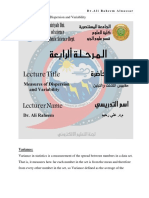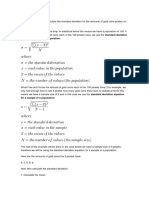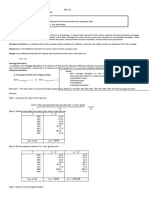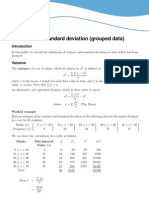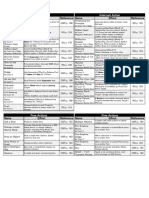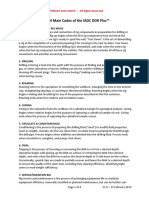STANDARD DEVIATION (SD) AND VARIANCE
SD is the most useful measure of dispersion (spread of items in the set)
SD measures how far scores tend to be from the mean, i.e. “it gives an approximate
picture of the average amount each number in a set varies from the centre” (Coolidge,
2013, p. 89)
Visually, a frequency distribution that has a lower SD has more scores closer to the
mean, and the one with a higher SD has more scores farther from the mean.
The SD is based on the deviation of each score from the mean
Variance is defined as the average of the squares of the deviations of a set of scores
from their mean.
Definition: The deviation of a score x from the mean 𝑥̅ is x - 𝑥̅ ,
Greek
letter If we have n values, x1, x2, .......... , xn and if 𝑥̅ is the mean value, then the standard
‘sigma’
deviation is
σ = √𝑚𝑒𝑎𝑛 𝑜𝑓 𝑠𝑞𝑢𝑎𝑟𝑒𝑑 𝑑𝑒𝑣𝑖𝑎𝑡𝑖𝑜𝑛 = √
(𝑥1 −𝑥̅ )2 + (𝑥2 − 𝑥̅ )2 +.……… + (𝑥𝑛 −𝑥̅ )2
𝑛
In short, the formula for expressing standard deviation is
σ = √∑(𝑥−𝑥̅ ) 2
∑(𝑥−𝑥̅ )2
is called the variance i.e. σ = √𝒗𝒂𝒓𝒊𝒂𝒏𝒄𝒆
𝑛
Steps to find the standard deviation
1. Find the mean
2. Find the deviation of each score from the mean (i.e. the difference between the mean
and each score 𝑥 − 𝑥̅ )
3. Square each deviation: (𝑥 − 𝑥̅ )2
4. Find the sum of the squared deviation ∑(𝑥 − 𝑥̅ )2
∑(𝑥−𝑥̅ )2
5. Divide the sum by n: 𝑛
6. Take the square root of (5) to obtain the standard deviation [Sonnabend, 2010;
Coolidge, 2013; Coolican, 2009].
1
� Examples
1. Find the standard deviation of the following sets of data: 2, 5, 6, 7, 7, 9
Answer: we need the mean score and then the square of the difference between each score and
the mean.
Mean = 𝑥̅ =36/6 = 6,
x x–𝒙
̅ ̅) 𝟐
(𝐱 – 𝒙
2 2 - 6 = -4 16
5 45– 6 = -2 4 2
-1
6 6–6=0 0
7 7–6=1 1
7 7–6=1 1
9 9–6=3 9
= 36 = 28
26
Therefore the standard deviation = σ = √286 = 2.16
2
�2. A survey was carried out on a housing estate to find the number of children per family. The results
from 50 families were
Number of children 1 2 3 4 5 6
Number of families 18 22 6 1 2 1
(a) Find the mean
(b) Find the standard deviation
Note: When there are frequencies given, the formula for finding the mean is:
∑𝒇𝒙
̅=
𝒙
∑𝒇
The formula for finding the standard deviation needs to be adopted in a similar way:
̅)2 𝑓
∑(𝑥− 𝒙
Standard deviation = σ = √ or a simple version of σ can be written as:
∑𝑓
∑𝑥 2 𝑓
σ = √ ̅𝟐
− 𝒙
∑𝑓
1×18+2×22+3×6+4×1+5×2+6×1
Answer: (a) mean = 50
100
̅ =
𝒙 = 2
50
3
�(b)
Number of Number of families x2 × f
children
f
x
x2
1 1 18 18
2 4 22 88
3 9 6 54
4 16 1 16
5 25 2 50
6 36 1 36
∑𝑓 = 50 ∑𝑥 2 𝑓 =
∑𝑥 2 𝑓
Therefore the standard deviation = σ = √ ̅𝟐
− 𝒙
∑𝑓
= √ − 𝟐𝟐
50
σ = √… = 1.11
4
� Finding Standard deviation of a grouped data
Example
The number of words per sentence on a page of a book were:
# of words 1-3 4-6 7-9 10-12 13-15
Frequency 3 38 59 27 4
Calculate
(a) The mean
(b) The standard deviation of the length of the sentence.
# of f Mid-interval x–𝒙
̅ ̅) 𝟐
(𝐱 – 𝒙 ̅) 𝟐
𝐟(𝐱 – 𝒙 fx
words x
1-3 3 2 -5.79 33.52 100.56 6
4-6 38 5 ........ ......... ...... ......
7-9 59 .......... .......... .......... ....... ......
10-12 27 ........ ........... .......... ....... .....
13-15 4 .......... .......... ........... ...... ......
Total ........ .............. ......
………..….
Estimated mean = = ........................
…………….
̅)2 𝑓
∑(𝑥− 𝒙 ………….
Standard deviation = σ = √ = √ = .................................
∑𝑓 …………..
5
� Exercise: The table gives the height of tomato plants four weeks after seeds were planted.
Height, h cm Frequency
0≤h≤3 2
Calculate the (a) estimated mean
3≤h≤6 5
6≤h≤9 10 (b) standard deviation
9 ≤ h ≤ 12 3
Answer:
Height, Frequency Mid- x–𝒙
̅ ̅) 𝟐
(𝐱 – 𝒙 ̅) 𝟐
𝐟(𝐱 – 𝒙 fx
h cm f interval
x
0≤h≤3 2
3≤h≤6 5
6≤h≤9 10
9 ≤ h ≤ 12 3
Total ........ .............. ......
(a) Estimated mean = ...........................................
(b) Standard deviation = ...........................................
















